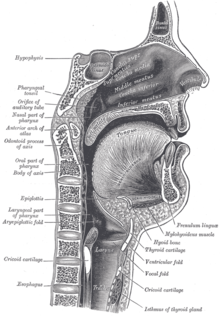Mouth
![]()
The title of this article is ambiguous. For other meanings, see Mouth (disambiguation).
![]()
This article has been entered for improvement due to formal or content deficiencies in the biology quality assurance. This is done to bring the quality of Biology articles to an acceptable level. Please help improve this article! Articles that are not significantly improved may be deleted if necessary.
Also read the more detailed information in the minimum requirements for biology articles.
The mouth (called mouth in animals), Latin Os, is the body cavity and surrounding soft tissues in the head that forms the uppermost part of the digestive tract. It is the body orifice through which food is taken in. It also serves to produce voice (phonetics) in humans and respiration in terrestrial vertebrates.
Depending on the creature and the external structure or function of the mouth, terms such as mouthparts, mouth or beak are used.
The mouth, or oral cavity, together with the nose, is the first part of the air conducting system, which, together with the gas conducting system, supplies the body with oxygen. Its task is to clean, warm and humidify the circulating air and transport it further into the pharynx. In the event of an allergic reaction (anaphylaxis), the tongue, which is located in the oral cavity, can swell and thus block the airways.

Sagittal section through the mouth
Etymology
The gemeingerm. word mhd. munt, ahd. mund is ambiguous: on the one hand it can be related to latin mentum "chin", on the other hand it can belong to the indogermanic verbal stem *menth- "to chew" in the sense of "chewer" and be related to latin mandare of the same meaning.
Developmental Biology
Animals generally have a digestive system in which food is taken in through the mouth and excreted through the anus. Which of the two body orifices is formed first during ontogeny determines the classification of animals as primordial (Protostomia, mouth first) or neuter (Deuterostomia, anus first).
Some animals, such as cnidarians or whirligig worms, do not have an anus; they excrete the digestive remains again through the mouth. Arthropods do not excrete at all; they digest without remains. Some endoparasites, such as tapeworms, do not possess mouths at all. As far as they live in the digestive system of a host, they can ingest components of its food directly through their outer skin.
Search within the encyclopedia